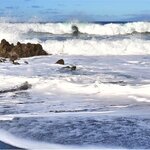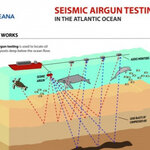Oceanography

Crocus and daffodil blossoms mean spring has arrived on land and a similar "greening" event, a massive phytoplankton bloom, unfolds each spring in the Atlantic Ocean.
But, what happens to all that organic material produced in the surface ocean?
In the North Atlantic Bloom, millions of microscopic plants use sunlight and carbon dioxide (CO2) to grow and reproduce at the ocean's surface. When the plants die, or are consumed by marine animals, some of their organic matter is transferred to the deep ocean, removing it from the atmosphere for years to come.
This biological pump makes the…

The ocean is a huge reservoir of dissolved organic molecules, many of them stable against microbial utilization for hundreds and even thousands of years. They contain a similar amount of carbon as compared to carbon dioxide (CO2) in the atmosphere and the origin of these persistent molecules has been something of an enigma.
Dissolved organic matter (DOM) in the ocean is a highly complex mixture of different carbon-based substances which are metabolic or excretory products from organisms or have formed through decomposition processes. A proportion of the DOM can be consumed by bacteria…
Though the developed world is concerned about greenhouse gas emissions implicated in climate change and global warming, reactions in nature have been less consistent.
Polar bears have been increasingly forced on shore due to sea ice loss, where they eat berries, birds and eggs, while ice seals, the usual lipid-rich prey of bears, couldn't be happier that thinner ice has made them harder to get to.
Writing in Ice Seal Ecology FTW, ecologists from the United States Geological Survey and Seals Versus Bears International noted that global warming has halted the unrelenting attacks by polar bears…

You never forget the first time you see an iceberg. The horizon of a ship at sea is a two dimensional space and to see a three dimensional piece of ice appear in the ocean is quite something.
But, in truth, the first iceberg you see is likely to be small.
Most icebergs that make it far enough north from Antarctica to where they are danger to shipping are sometimes many years old and at the end of their lives. They are small fragments of what once left the continent.
Once in a while, however, a monster breaks free from the edge of Antarctica and drifts away. Tens of kilometres long these…

A 10 year project to observe and analyze regular data about ocean circulation and how it impacts on Britain’s climate has provided new insight into Atlantic Meridional Overturning Circulation (AMOC), a major system of currents in the North Atlantic.
10 years is too short a time to be meaningful but it is an important milestone. Since 2004, the project team has been monitoring the AMOC at 26.5N degrees, near where it carries its maximum heat, using instruments moored at 30 locations across the Atlantic between the Canary Islands and the Bahamas - so-called fixed arrays. The arrays’ instruments…

To combat possible climate change due to greenhouse gases, a mix of alternative energy sources (except nuclear for the United States) and geoengineering schemes have been proposed. One idea proposes that ocean pipes could facilitate direct physical cooling of the surface ocean by replacing warm surface ocean waters with colder, deeper waters.
A new study from a group of Carnegie scientists determines that these types of pipes could actually increase global warming quite drastically.
The researchers configured a model to test this idea and what they found surprised them. The model…

Microbial communities in different regions of the Pacific Ocean displayed strikingly similar daily rhythms in their metabolism despite inhabiting extremely different habitats, according to a new study.
From the nutrient-rich waters off California to the nutrient-poor waters north of Hawai'i, dominant photoautotrophs - light-loving bacteria that need solar energy to help them photosynthesize food from inorganic substances - appear to initiate a cascade effect wherein the other major groups of microbes perform their metabolic activities in a coordinated and predictable way. As expected,…

Ocean tides have changed significantly over the last century at many coastal locations around the world, according to a paper in
Earth’s Future, and increases in high tide levels and the tidal range were found to have been similar to increases in average sea level at several locations.
Average sea levels are rising but tide levels have undergone little change on decadal time scales, nor will they change much over the next century, so long-term changes in tides are not a concern in computer models trying to predict the effects of rising sea levels.
Not so, finds the authors, who used a…

75 marine scientists have sent a letter to President Obama scolding the administration for its policies on seismic airgun blasting in the Atlantic Ocean,
The policy on airgun blasting represents the arbitrary and capricious nature of environmental policy in the Obama administration. Though multiple studies conducted by government scientists found no environmental harm from the Keysone XL pipeline - a few hundred miles of new, safe pipeline among the 20,000 that already exist in the area was not going to risk anything - President Obama vetoed that but has greenlit airgun blasting despite…

Too cold for a penguin? An Ice Age brought on by global warming so severe penguins had to move?
Indeed. During the last interglacial, what is colloquially called an ice age though it has been such non-stop for a few million years, only three populations of emperor penguins may have survived, because much of the rest of Antarctica was uninhabitable due to the amount of ice.
30,000 years ago, the Ross Sea in Antarctica was likely the refuge for one of these populations. Cold conditions in the past were too extreme for large populations to survive. Researchers examined the genetic…